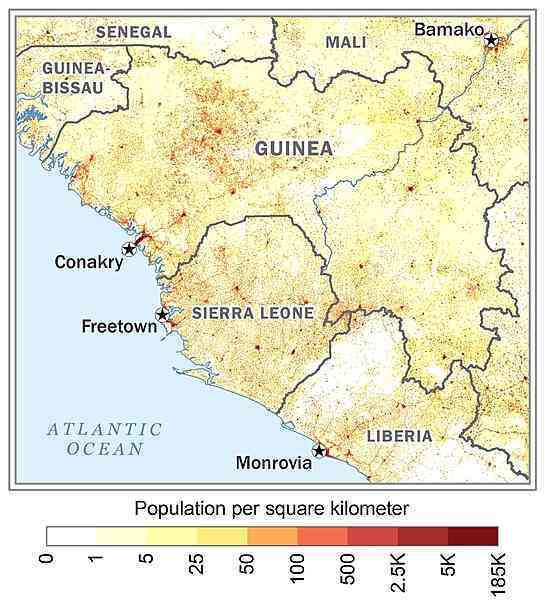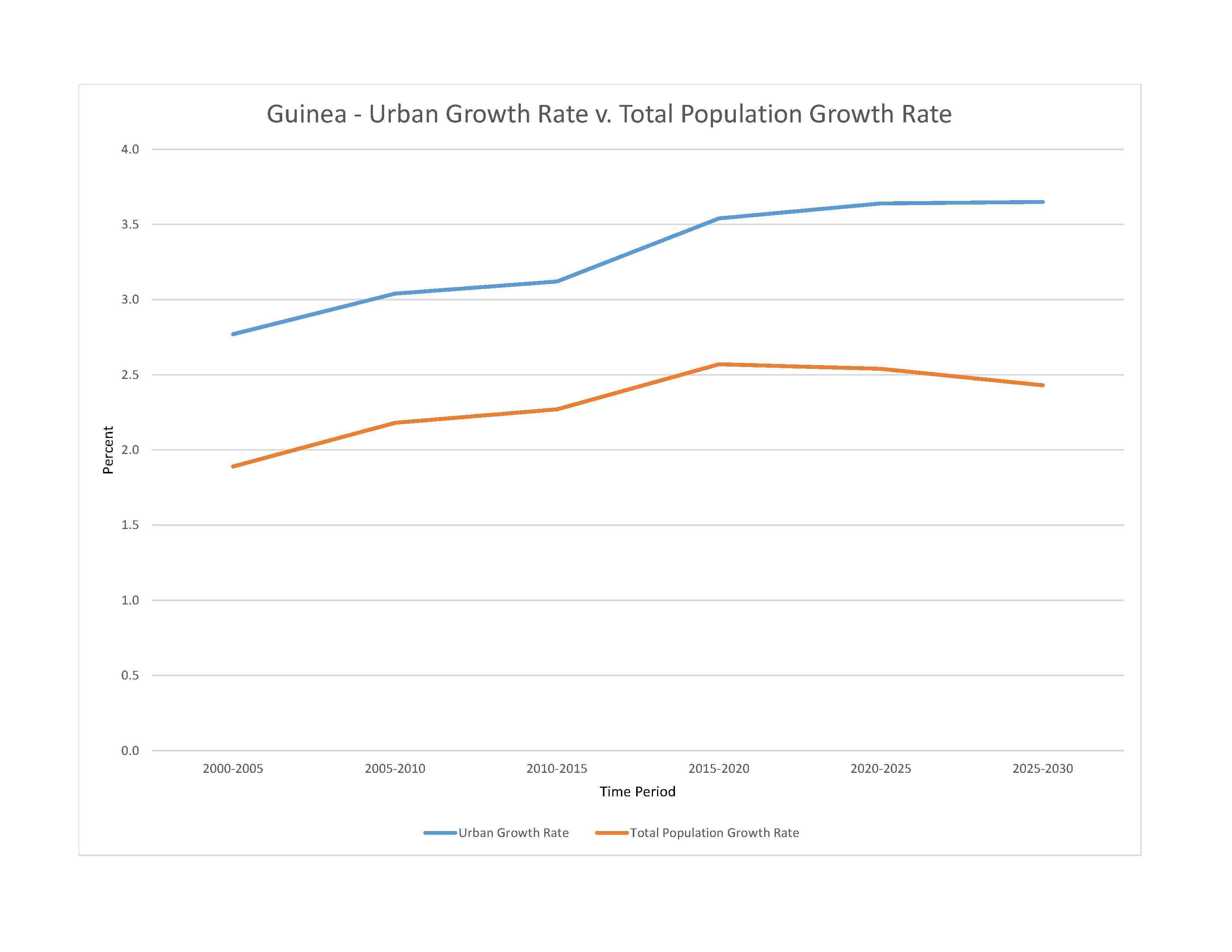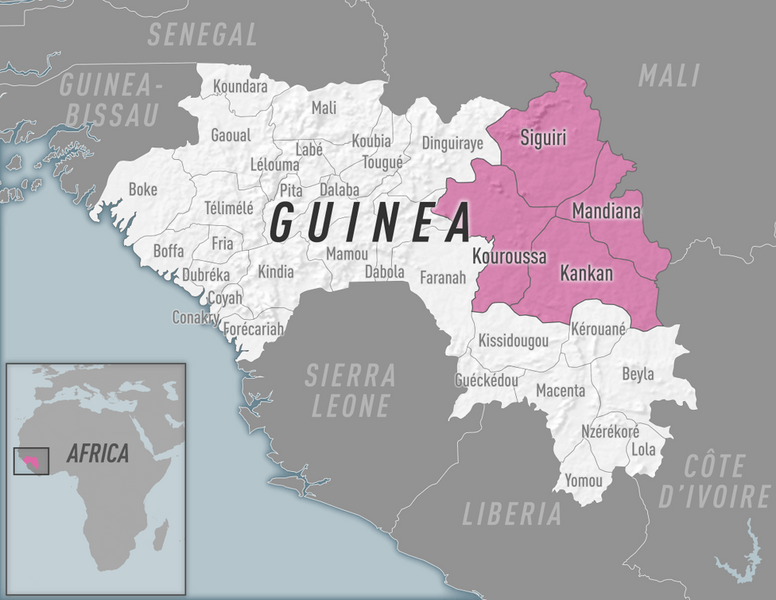
13,607,249 (2023 est.)
noun: Guinean(s)
adjective: Guinean
Fulani (Peuhl) 33.4%, Malinke 29.4%, Susu 21.2%, Guerze 7.8%, Kissi 6.2%, Toma 1.6%, other/foreign 0.4% (2018 est.)
French (official), Pular, Maninka, Susu, other native languages
note: about 40 languages are spoken; each ethnic group has its own language
Muslim 89.1%, Christian 6.8%, animist 1.6%, other 0.1%, none 2.4% (2014 est.)
Guinea’s strong population growth is a result of declining mortality rates and sustained elevated fertility. The population growth rate was somewhat tempered in the 2000s because of a period of net outmigration. Although life expectancy and mortality rates have improved over the last two decades, the nearly universal practice of female genital cutting continues to contribute to high infant and maternal mortality rates. Guinea’s total fertility remains high at about 5 children per woman as of 2022 because of the ongoing preference for larger families, low contraceptive usage and availability, a lack of educational attainment and empowerment among women, and poverty. A lack of literacy and vocational training programs limit job prospects for youths, but even those with university degrees often have no option but to work in the informal sector. About 60% of the country’s large youth population is unemployed.
Tensions and refugees have spilled over Guinea’s borders with Sierra Leone, Liberia, and Cote d’Ivoire. During the 1990s Guinea harbored as many as half a million refugees from Sierra Leone and Liberia, more refugees than any other African country for much of that decade. About half sought refuge in the volatile "Parrot’s Beak" region of southwest Guinea, a wedge of land jutting into Sierra Leone near the Liberian border. Many were relocated within Guinea in the early 2000s because the area suffered repeated cross-border attacks from various government and rebel forces, as well as anti-refugee violence.
0-14 years: 40.96% (male 2,809,865/female 2,763,294)
15-64 years: 55.05% (male 3,741,047/female 3,749,281)
65 years and over: 4% (2023 est.) (male 245,323/female 298,439)
total dependency ratio: 82.4
youth dependency ratio: 76.3
elderly dependency ratio: 6.1
potential support ratio: 16.3 (2021 est.)
total: 19.3 years (2023 est.)
male: 19.1 years
female: 19.6 years
2.75% (2023 est.)
35.5 births/1,000 population (2023 est.)
8 deaths/1,000 population (2023 est.)
0 migrant(s)/1,000 population (2023 est.)
areas of highest density are in the west and south; interior is sparsely populated as shown in this 
urban population: 38.1% of total population (2023)
rate of urbanization: 3.64% annual rate of change (2020-25 est.)

2.111 million CONAKRY (capital) (2023)
at birth: 1.03 male(s)/female
0-14 years: 1.02 male(s)/female
15-64 years: 1 male(s)/female
65 years and over: 0.82 male(s)/female
total population: 1 male(s)/female (2023 est.)
19.9 years (2018 est.)
note: data represents median age at first birth among women 20-49
553 deaths/100,000 live births (2020 est.)
total: 48.3 deaths/1,000 live births (2023 est.)
male: 53 deaths/1,000 live births
female: 43.5 deaths/1,000 live births
total population: 64.3 years (2023 est.)
male: 62.4 years
female: 66.2 years
4.82 children born/woman (2023 est.)
2.37 (2023 est.)
10.9% (2018)
improved: urban: 99.5% of population
rural: 76.9% of population
total: 85.2% of population
unimproved: urban: 0.5% of population
rural: 23.1% of population
total: 14.8% of population (2020 est.)
4% of GDP (2020)
0.23 physicians/1,000 population (2018)
0.3 beds/1,000 population (2011)
improved: urban: 90.9% of population
rural: 38.7% of population
total: 58% of population
unimproved: urban: 9.1% of population
rural: 61.3% of population
total: 42% of population (2020 est.)
degree of risk: very high (2023)
food or waterborne diseases: bacterial and protozoal diarrhea, hepatitis A, and typhoid fever
vectorborne diseases: malaria, dengue fever, and sexually transmitted diseases: hepatitis B (2024)
water contact diseases: schistosomiasis
animal contact diseases: rabies
aerosolized dust or soil contact diseases: Lassa fever
note: on 20 September 2023, the Centers for Disease Control and Prevention updated a Travel Health Alert for a diphtheria outbreak in several states in Guinea; vaccination against diphtheria is essential to protect against disease; if you are traveling to an affected area, you should be up to date with your diphtheria vaccines; before travel, discuss the need for a booster dose with your healthcare professional; diphtheria is a serious infection caused by strains of Corynebacterium diphtheriae bacteria that make a toxin from which people get very sick; diphtheria bacteria spread from person to person through respiratory droplets like from coughing or sneezing; people can also get sick from touching open sores or ulcers of people sick with diphtheria (see attached map)
Diphtheria outbreak in Guinea.: 
7.7% (2016)
total: 0.33 liters of pure alcohol (2019 est.)
beer: 0.29 liters of pure alcohol (2019 est.)
wine: 0.01 liters of pure alcohol (2019 est.)
spirits: 0.03 liters of pure alcohol (2019 est.)
other alcohols: 0 liters of pure alcohol (2019 est.)
16.3% (2018)
68.7% (2023 est.)
women married by age 15: 17%
women married by age 18: 46.5%
men married by age 18: 1.9% (2018 est.)
2.2% of GDP (2020 est.)
definition: age 15 and over can read and write
total population: 45.3%
male: 61.2%
female: 31.3% (2021)
total: 9 years
male: 10 years
female: 8 years (2014)
NOTE: The information regarding Guinea on this page is re-published from the 2024 World Fact Book of the United States Central Intelligence Agency and other sources. No claims are made regarding the accuracy of Guinea 2024 information contained here. All suggestions for corrections of any errors about Guinea 2024 should be addressed to the CIA or the source cited on each page.
This page was last modified 04 May 24, Copyright © 2024 ITA all rights reserved.